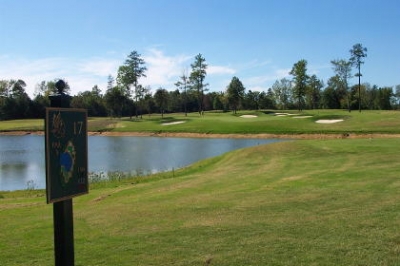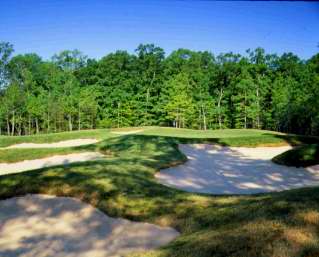By Jeffrey A. Rendall, Photos By Jeff Janas
GLEN ALLEN, VA -- Almost as if in the words of a John Denver song, when I see a hawk gliding effortlessly through the air, my mind yields several impulsive thoughts. The first is freedom (no, I'm not confusing a hawk with an eagle here); the second is power; and the last is nature.
A hawk is one of those creatures that's hard to contemplate, because of its ability to overcome any number of habitudinal challenges and still survive. Somehow, you'd expect this type of bird to move far away from human civilization if threatened, only to find safe harbor near some glistening mountain lake far off in your consciousness.
But it doesn't. It's resilient. A hawk is nature thumbing its nose at progress, because it adapts to whatever moves towards it.
 |
| The par three 6th hole may be relatively short, but if you're off the green, you're probably in trouble. |
So when faced with such resiliency, people might do better by becoming more like a hawk - take a page out of nature's handbook and mold their surroundings into a natural oasis. And that's what they've done at Hunting Hawk Golf Club in Glen Allen, Virginia (northwest of Richmond in the central part of the state).
Though I'd hardly claim a golf course constitutes a nature conservancy, you're certainly seeing a lot more attempts these days at trying to bring back the wilderness feeling to golf properties - and to protect what's already there. Frequently spotted are the 'Protected Wetlands, Keep Out' signs, which create safe havens for flora and fauna as well as wayward golf balls. Ever wondered just how many are in there? Staggering.
Much of the newer focus on golf course habitat is probably due to increasingly stringent state and federal environmental standards and the poorer quality of existing potential golf sites. It makes sense -- if you've got a large chunk of solid ground, it's probably more economically sound to build houses or businesses on it. In the alternative, if you've got some low-lying swampy marsh, that's a good place to build a golf course.
Whatever the reason, the HH Hunt Company created an environmentally sound winner with this Bill Love (formerly with Ault, Clark and Associates) designed layout that's now known as Hunting Hawk. Eric Smith, the course's General Manager and Head Golf Professional, says the facility got its name because two hawks stayed on the property all throughout construction - and they're still there. Kudos to the decision-makers -- naming the course after these steadfast birds was an excellent choice.
 |
| At 226 yards, the 8th hole is a muscular par three. |
But Smith says paying homage to nature was more than just in the name. "Bill Love saw the site and wanted to preserve as much of the natural setting as possible -- and sought to make the course environmentally friendly. It was designed to fit well into the surrounding landscape, with no outside interruptions or development directly on the golf course. In other words, the natural environment was meant to enhance the course."
Smith continues, "Love wanted the course to change with the seasons -- so he left some non-irrigated areas and native grasses in the design to provide that feeling. And not a lot of dirt was moved. We've also got bird houses out there, and we're doing whatever we can do to keep it as environmentally friendly as possible."
Once you're out playing Hunting Hawk, you'll certainly notice how much of the environment is still out there -- quite a bit. Environmentally protected wetlands areas come into play on half the holes, and on the others, there're plenty of trees and water to gawk at. Number twelve, a mid-length par three, features a full nature (wetland) carry to the green. If you're a member of the Sierra Club, this might be your golf course.
But don't get the wrong impression. Smith says playability wasn't sacrificed to the God of Green Space. "The course was designed to play very fair, and I think it's turned out that way. From the back tees it's a pretty tough test with some forced carries, but if you're a higher handicapper and move forward to a shorter set, everything's pretty straightforward. No surprises."
 |
| The 568 yard, par five 9th hole presents several options on the second shot, but if you don't get your tee shot in the fairway, none are very attractive. |
"We've also got a lot of variety on our course -- holes of different lengths, holes facing different directions, some pretty tough holes and some easier ones. Those are the two words I'd use to describe our layout -- variety and playability," Smith adds.
You definitely get these impressions when you're playing Hunting Hawk. You'll also probably think the course will only improve with time, condition-wise. Smith said they've had a very hot and dry summer, and the non-irrigated areas are feeling the effects. I'd say the playing space is in pretty good shape for a two-year-old course, but some moisture will be needed to bolster the in-betweens, as would be expected.
As a final note before I describe some of the layout, the greens are also very playable, with mild undulations and reasonable putting speeds. In other words, if you're doing a good job of staying out of the environmental areas, you'll have a chance to make a few putts. That's fair enough.
The course starts out with a practical 417 yard par four, slightly downhill and straightaway. There're trees down the left side, closer to the green area, but very little to threaten your tee ball from this wide-open landing area. Just keep it in the fairway -- the Bermuda rough is formidable (all throughout the course, actually).
 |
| Looking back at the 17th green from the 18th tee, you'll see the lake that almost got your golf ball. |
Three is the first of four reachable par fives, 513 yards from the tips. It's also your first introduction to the wetlands on the course, having greeted water on the previous hole. There's a large bunker down the right side of the driving area, but plenty of room to the left. If you choose to lay-up, do so in the area in between the wetlands on the left and a large bunker to the right that guards the short approach to the putting surface. Good hole concept.
Six is the first par three on the course, so don't be shocked if you see some fives and sixes on your card for the first five holes and wonder how your score's ballooning. It's definitely got the Hunting Hawk look to it, with wetlands to the distant right side and a huge bunker guarding short and right of the green. It appears from the tee as if the bunker's a series of smaller traps, but it's an optical illusion -- just one big sand monster. But the hole only plays to 152 yards, so this is a good one to mark down a '3' and move on.
Seven's an unusual par four -- not exactly short at 437 yards, and a band of wetlands crosses the fairway at the 255 yard point. So, assuming you can't hit a driver 270 yards on the fly, the hole calls for a lay-up short, then a long iron to the green - or, in the alternative, a second lay-up, to a par four. Odd.
Nine's a great par five. Rip a driver to this straight-on hole -- and hopefully reach the crest of a plateau in the fairway, which will provide some roll on the other side. If this is the case, you might have a shot at the green in two -- but you'll have to carry water the whole way -- probably 220 yards worth. Or, lay-up to the left and cut off most of the water on your third shot. Choice in this respect, is a good thing.
 |
| The bane of photographer Jeff Janas -- the 12th hole's 184 yards of wetland carry, and no doubt there are hundreds of golf ball victims in there. |
The backside plays slightly more difficult in my opinion -- mainly due to the ominous presence of wetlands on what seems like most of the holes, and some long and difficult par fours.
Eleven presents the best birdie possibility on the inward nine. It's 526 yards long, but if your drive carries another plateau, you'll definitely have a shot at the green in two (unless you're a yard off the fairway in the thick Bermuda rough, like I was). In that case, lay-up to the left of the water -- plays similar to number nine, but not quite as long or difficult.
Twelve's the par three with the full wetlands carry. It's photographer Jeff Janas' worst nightmare - talk about a mental block! Beautiful to look at, but it gets in your head.
Thirteen probably should be a par five. 451 yards from the back, it's an uphill drive over -- you guessed it, wetlands, to a wide fairway -- but even with a great drive you'll still have a long iron or fairway wood to reach the vicinity of the green. Four on this hole would feel like a birdie.
 |
| Here's a look at the 17th from the tee box. Hazards abound, in the water and sand variety. |
Sixteen's the last par five, and completes the quartet of good ones at Hunting Hawk. It presents a different kind of challenge -- and opportunity -- than the previous three-shotters. The drive's the key, because there's a lake to the left, and woods to the right. If you have a good drive, you may have a reasonable opportunity to run it close with your second, because there aren't any hazards directly in front of the green -- and there's ample bailout room to the right.
Seventeen's an aesthetically pleasing 156 yard par three with a full water carry.
Eighteen's a tough closing hole, playing 443 yards and uphill. Not as much water or wetlands to deal with here -- just a stream that shouldn't come into play unless you top one off the tee box. Several bunkers wait to the right of the landing area. The second shot will be a long iron, but the green's reasonably open in front to a run-up shot.
We didn't see any hawks on our trip around Hunting Hawk Golf Club, but that doesn't mean we couldn't appreciate what the golf architect and developers tried to do when creating the course. Here, nature and the environment did not play second fiddle to bulldozers and lofty course construction concepts. Everything seems to fit well - golf and nature blend together as one. Just watch out when you're pulling the stickers out of your socks after chasing your ball into the wetlands (remember, keep out!) - because preserving nature can sometimes be a thorny proposition.
 |
| Photo courtesy of Hunting Hawk |
Note: Hunting Hawk was named #3 'Best New Affordable Public' for 2002 by Golf Digest.
Details:
Hunting Hawk Golf Club
15201 Ashland Road
Glen Allen, VA 23059
Phone: (804) 749-1900
FAX: (804) 749-1926
Website: www.huntinghawkgolf.com
Course Designer: Bill Love
General Manager: Eric Smith
| Tees | Yardage/Slope | |
| Talon | 6832/137 | |
| Black Hawk | 6440/132 | |
| Gray Hawk | 6021/129 | |
| Red Hawk | 5164/120 |
Rates:
Mon-Thurs, $45; Friday, $52; weekends, $60. Twilight rates as low as $35, as high as $60. Fee includes greens fee, cart, tax & range balls. (Call for Winter Rates.)
| Related Links | Comments on this article? | |
|
Maryland National Golf Club Hollow Creek Golf Club Rocky Gap Resort PB Dye Golf Club in Ijamsville Whiskey Creek Golf Club |
E-mail Jeff Rendall, Editor: jrendall@golftheunitedstates.com |












